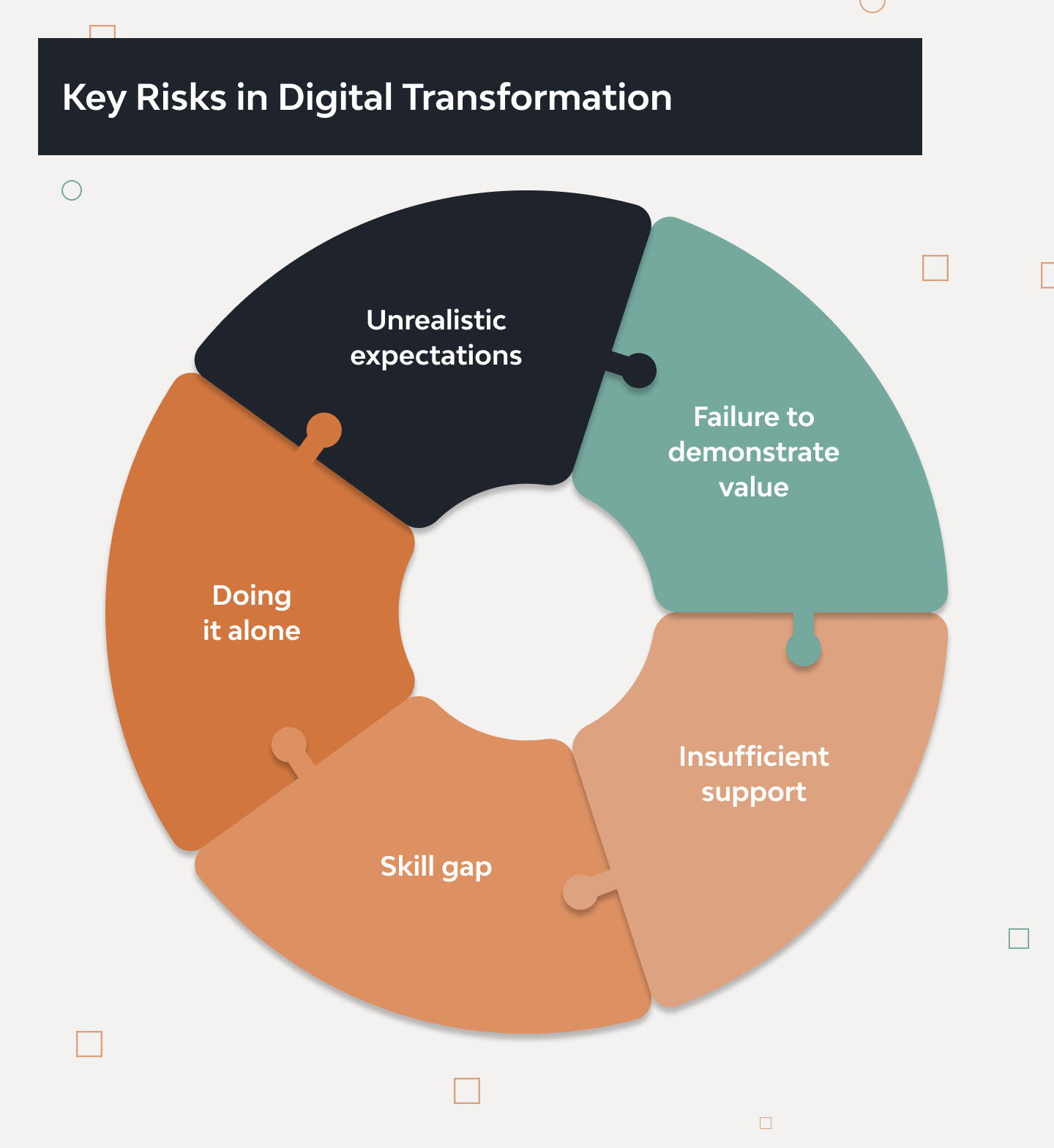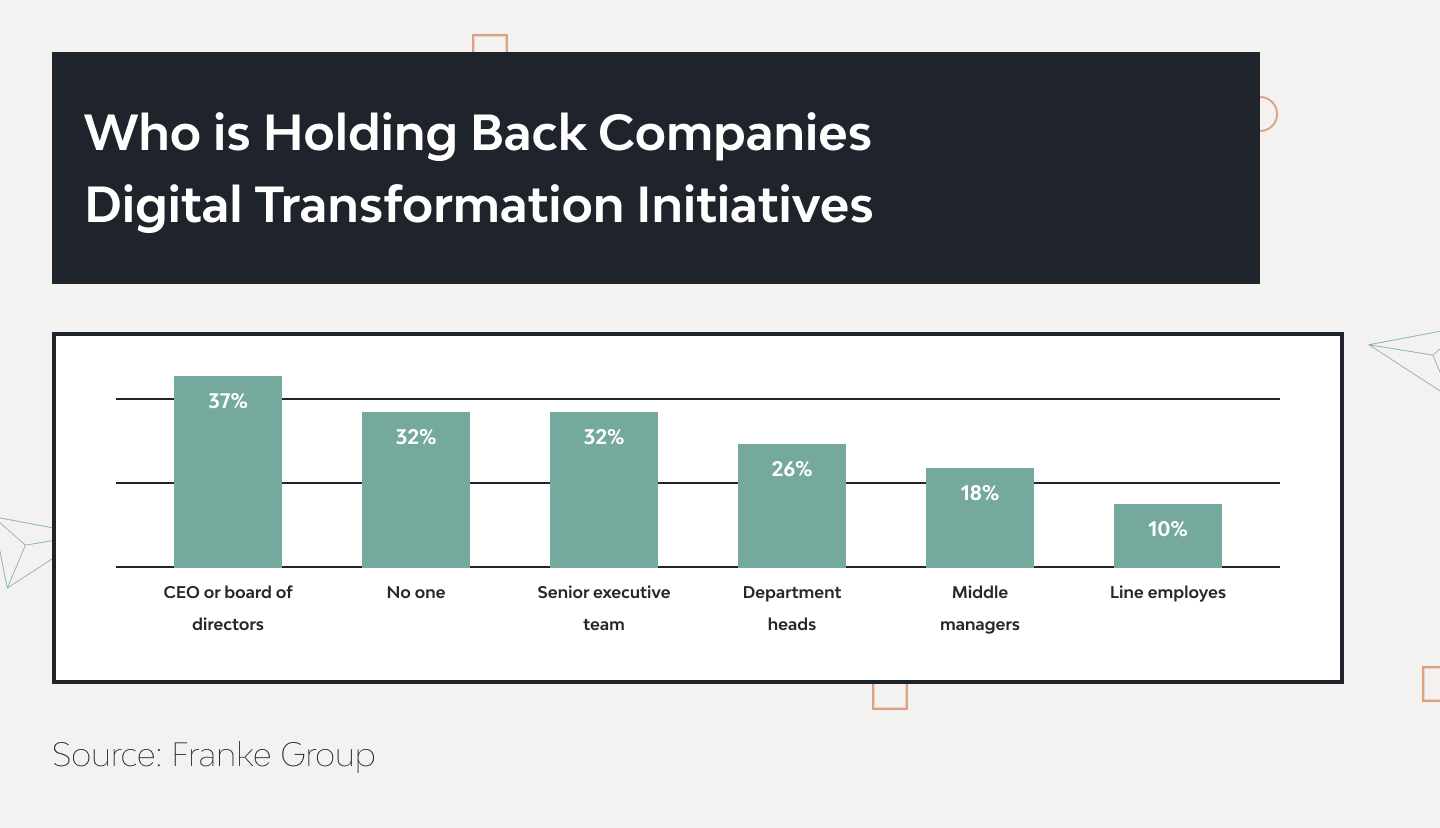Top 5 Digital Transformation Challenges to Avoid

Digital transformation is more than just a buzzword in conferences. Nowadays, it is a key for the optimization of processes and sustainable growth for the company. McKinsey analysts define it as the fundamental rewiring of how an organization operates. Naturally, this rewiring revolves around implementing technologies at scale to improve customer experience and lower costs.
Since it is a fundamental rewiring of processes, digital transformation involves a long-term effort to shift how an organization continuously improves and changes. It takes recognition that technology is not only becoming further integrated into business but is also constantly evolving.
Apart from many changes in the organization, it also takes substantial planning, risk assessment, and risk management. In this article, we will highlight the most common digital transformation risks and challenges with some guidelines on how to mitigate them.
Common Risks in Digital Transformation
Digital transformation, while essential for organizational growth, comes with inherent challenges. When handled poorly, these can impede progress and hinder success. Recognizing and mitigating these common digital transformation risks that businesses encounter is crucial for ensuring a seamless transition to a digitally empowered future and preventing mistakes along the way.
1. Having unrealistic expectations for the process of digital transformation
Some call it a shiny object, and others see it as unrealistic expectations, but the result of starting the process without assessing the risks associated with digital transformation. Whether it is IoT, sales process automation, or AI one wants to try, it is crucial to see how it will perform in a particular business setting. Organizations and their stakeholders must be wary of setting overly optimistic or misguided goals. Such attitudes may lead to disappointment and project derailment. Pitfalls may arise when timelines and outcomes are not aligned with the complexities of transformation initiatives.
2. Lack of the requisite skill set to support the initiatives for digital transformation
One prevalent risk in digital transformation is the lack of a necessary skill set to support initiatives effectively. Namely, if the company needs to have professionals who understand the functionalities of the technology and specifics of the processes within the existing business model, the transformation may not go well.
Successful transformation requires skilled professionals who can navigate the evolving technological landscape. Highlighting the critical role of expertise ensures organizations prioritize acquiring the talent needed to drive and implement transformation initiatives.
Django Stars steps in to fill this void. We not only bring technical expertise but also offer training and development for the client’s team. By doing so, we ensure that the organization is not only prepared for the current transformation but is also equipped with skills for future challenges.
3. Insufficient leadership support
The lack of involvement of the decision-makers and stakeholders is a potential roadblock in digital transformation efforts. This is a complicated process with multiple benchmarks, so only approving the direction and the plan is not sufficient without consistent participation or at least awareness. Projects may face resistance and struggle to gain momentum without committed and engaged leaders, who manage the process as it runs.
4. Not showing real values
The main point of digital transformation is to make the existing product or service better and more efficient. Failing to communicate and demonstrate the tangible value of digital transformation initiatives poses a significant risk. Aligning efforts with measurable outcomes is essential for showcasing real value and garnering continued support.
5. Working without the help of a partner who understands the digital landscape
The digital landscape is intricate and ever-evolving, necessitating specialized assistance. Practically, it is best to have a team that has done projects like yours and has relevant expertise in the business domain. Collaborating with a seasoned partner increases the chances of navigating complexities effectively. Thus, the business has to engage the right expertise to easily dodge the risks of digital transformation.
Top Strategies for Mitigation the Digital Transformation Risks
It takes investing in comprehensive strategic risk management in digital transformation to ensure a smooth and successful journey. No project is trouble-proof, but there are strategies that allow to minimize risks associated with digital transformation. The strategies below can enhance the likelihood of positive outcomes in the dynamic landscape of digital evolution.
1. Rise risk ownership
Effective risk management in digital transformation begins with understanding and assigning ownership. It involves entrusting individuals or teams with the responsibility to identify, assess, and mitigate risks. Such a framework fosters accountability and proactive risk management. An agile system of commitments, roles, and reporting makes responsibilities clear and the process transparent.
2. Find and manage risks in an agile manner
Digital transformation is a dynamic process. Planning and launching it needs an agile approach to risk management. Identifying and managing risks in real time allows organizations to adapt swiftly to changes. In a framework that has space for evaluation of the results and retrospective analysis of potential issues, the team can promptly address and adjust to them.
3. Modernize risk assessment
Traditional risk assessment methods may fall short short today. Thus, it is important for decision-makers to keep up with the best practices in their own and technological industries. Modernizing the assessment of digital transformation risks and challenges adapting strategies to the real-time conditions of the landscape streamlines the process. It can include current technological advancements, such as machine learning or artificial intelligence that predict precise outcomes of the planned innovations.
4. Automate risk controls
Large companies that have already started the digital transformation journey take a technological approach to risk management. These businesses automate monitoring and testing too, using approaches like “compliance as code” to ensure that risk-related requirements are met.
Today’s technology allows for streamlining the controls like distribution of duties, code reviews, and application security testing by embedding them in their continuous integration and deployment flow. Such a cohesive integration ensures that risk management becomes an integral part of the development lifecycle.
5. Invest in changing attitudes
Companies sometimes overlook involving risk subject-matter experts more closely in daily team activities. These experts can contribute to finding solutions rather than being perceived as obstacles, all while maintaining their objectivity.
Another powerful way to shift attitudes is by introducing performance metrics. Objectives and key results (OKRs) for performance management will serve sd indicators for the team and stakeholders about the direction that the process is taking. When product owners take accountability for these metrics contribute to gradually to the change.
Case Studies and Examples
Django Stars’ track record has multiple successful cases of launching and managing risks in digital transformation. The team, with extensive expertise in developing fintech projects and implementing technology at diverse scales within the business. Among the cases of digital transformation in banking Molo Finance and Money Park rightfully stand out.
Whether the banking business seeks technological enhancement of existing processes or builds a fintech product around the technology, Django Stars can roadmap the process, pinpoint risks, and keep the stakeholders engaged. The dedicated team actively involves risk subject-matter experts in daily activities, emphasizing their role in finding solutions rather than hindrances.
Additionally, the team integrated risk-related metrics into performance management, creating a positive risk-aware culture that aligns with the specific needs of each project.
Another case in point is the way Django Stars teams approach digital transformation in mortgage industries. The biggest challenges in money-related industries are vulnerability to outside disruptions, the complexity of infrastructure to be developed, and digital transformation security risks for the product and the whole company.
For Django Stars, implementing this transformation the mortgage industry has a focus on customer demands for simplicity and transparency combined with the operational efficiency of the product itself.
For example, in the case of Molo Finance, the team mitigated the risk of unrealistic expectations by performing a thorough discovery phase and identifying the technology for the solution. Additionally, for the company collaboration with a professional team with relevant cases in their industry alleviated the risk of having insufficient expertise on board.
To avoid insufficient leadership support, the team created a comprehensive plan of approvals and reporting to keep the stakeholders tuned in the development process according to agile frameworks. The involvement of the leadership allowed the team to identify emerging issues early on and adjust the further action plan accordingly. Finally, a dedicated team of engineers and managers contributed to clear responsibilities throughout the development of risk ownership for every particular case.
As a result, the team digitalized the mortgage process for the company and provided it with the competitive advantage of secure online transactions and a simple user experience for its clients.
How Can Django Stars Help You to Mitigate Risks Associated with Digital Transformation?
Django Stars is a technological partner for companies navigating the digital transformation risks and challenges. The team offers comprehensive consulting and development services tailored to elevate and expand particular business goals. Unlike merely digitizing existing products and services, it focuses on transforming business processes into robust, user-centric, and scalable systems that ensure predictability and growth.
1. Though-through user experience
The team takes time and effort for audience analysis, user journey optimization, and extensive personalization capabilities. This approach ensures a positive and tailored experience for the product user. This way, it is easier for customers to perform the targeted action, which makes using the service easier and improves loyalty to the brand.
2. Transparent operations
On the journey of the digital transformation of the product, the team aims for clarity and high-quality data. The transformation with the digital tools hand-picked for the business case optimizes processes, streamlines operations, and enhances their transparency. This way, it is easier and faster for the employees to accomplish their tasks efficiently.
3. Data-driven processes
Django Stars implements tools that enable data-driven decision-making with minimal manual input. Enhanced product features require less human resources to operate and minimize the chances of human-related errors. This strategic approach ensures a competitive edge in the dynamic business landscape.
4. Routine automation
These digital transformation solutions incorporate routine automation for complex tasks, allowing your team members to focus on high-level responsibilities and innovation.
Digital transformation solutions implemented by Django Stars
- processing tools for handling large data sets
- analytics and reporting instruments for insightful business intelligence
- cloud-based data storage for flexible and accessible data management
- process automation to enhance operational efficiency
- performance management tools for continuous improvement
- seamless third-party integrations for enhanced functionality
- robust data security measures for protection and compliance
Django Stars is committed to empowering organizations through strategic digital transformation. The team crafts each solution for a particular business and audience to ensure sustainable growth and a competitive edge for the organization.
Read Also: Sustainable Startups Growth
Conclusion
Digital transformation is a big step for any business, especially if its nature is predominantly offline or analog-based. The technologies available today allow for improving the company’s performance and streamlining operations on any scale: from a single process within the company to its complete rewiring to the digital capacities.
This step promises the business significant improvement in the long run. However, it requires comprehensive research and planning to implement. Even at this initial phase, organizations face a number of challenges and risks in digital transformation, such as unrealistic expectations, insufficient requisite skills, lack of leadership involvement, and lack of expertise.
Getting professional and personalized guidance from a trusted tech partner will both minimize the risks of digital transformation and make the process of transformation as painless for the organization as it can be.
How can organizations identify and prioritize risks in their digital transformation initiatives?
- Organizations can conduct comprehensive risk assessments by involving key stakeholders and evaluating the potential impact and likelihood of risks. Prioritization should focus on critical areas impacting business objectives and customer experience. To avoid blindspots in assessment and planning, it is advisable to involve a tech team with relevant expertise and experience in digital transformation.
How can organizations define the areas for implementing digital technology?
- Businesses can identify areas for digital technology within the existing workflows and processes by assessing current inefficiencies, customer pain points, and market trends. Along with that, stakeholders need to research the available technology to define whether it fits their company's needs. This process involves collaboration between IT and business teams to align technology solutions with strategic goals.
How can leaders and executives support risk management efforts during digital transformation?
- Stakeholders and leadership can support risk management in digital transformation by setting up protocols and channels for open communication and allocating resources for comprehensive risk assessments. It is crucial for stakeholders to actively participate in strategic decision-making related to risk mitigation and oversee the progress of implementation.
How can organizations encourage employees to adopt a risk-aware mindset?
- Organizations can motivate employees to adopt a risk-aware mindset through training programs, timely communication on risk-related objectives, and setting performance metrics for the implementation progress. Digital transformation of the business will require including the resources for onboarding of both employees and the company’s customers.










